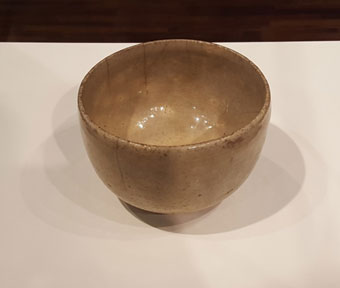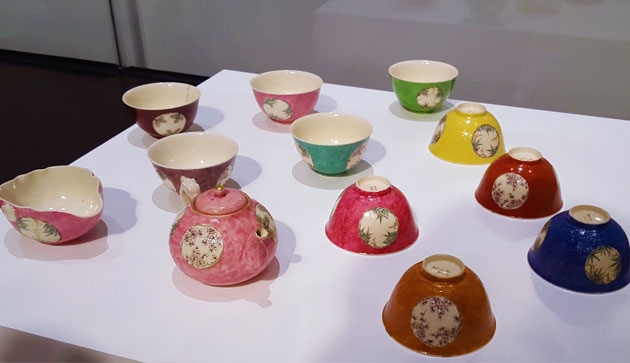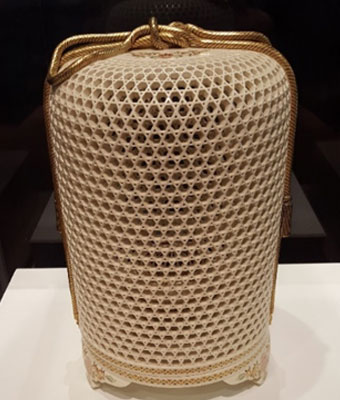On September 18th, the Seoul National University museum opened another outstanding exhibition. “The 400 Year Legacy of the Joseon Craftsman – Shim Soo Kwan Exhibition” displays the works of Shim Soo Kwan, one of the most prominent producers of Satsuma pottery. Shim Soo Kwan is the title of the master craftsman and the eponymous modern day ceramic manufacturer. The Shim family’s practice in pottery covers a history of 15 generations of master craftsmen. The exhibition holds a collection of earthenware pieces that represents the legacy of the craftsman family.
The Shim Soo Kwan legacy in pottery originates from the Joseon kingdom, precursor to modern Korea. The first Shim Soo Kwan, Shim Dang Kil, was taken prisoner by the Japanese during the final stages of the Japanese invasions of Korea in 1598. Shim settled and established his trade in Satsuma, where his craft has been handed over and developed by future generations to this day.
The exhibition depicts a progression of the works from the first to the current 15th Shim Soo Kwan. The gallery begins with a small simple piece named Hibakari Dawan crafted by the first Shim Soo Kwan in the early 17th century. Hibakari translates to “only fire”, while Dawan means tea bowl. The piece was named so as the craftsman used only fire from Japan and all the other elements for the ceramic piece, such as clay, glaze and technology, were of Joseon origin. The subdued simplicity of the work, characterized by a lack of ornamentation, seems to provide the canvas for the future Shim Soo Kwan to embellish and develop upon the foundation. Shim Dang Kil would go on to find white clay in Satsuma and develop his craft into what is now known as Satsuma-ware.

Hibakari Dawan (early 17th century) by the 1st Shim Soo Kwan
The next series of works in the gallery take a leap in generations and depict the works of the 12th Shim Soo Kwan. Whereas the previous Shim Soo Kwan were craftsmen serving the regional Satsuma lord, the Meiji restoration in the late 19th century changed the dynamics of the crafts trade. The centralization of power to the Meiji government shut down the support to regional craftsmen and the 12th Shim Soo Kwan took a risk by acquiring the regional manufacturing plant and independently managing the pottery business without a patron. The Shim Soo Kwan was already recognized by westerners as it was displayed at the World Exposition in Austria in 1873, and the beautiful ceramic works were highly sought after by global markets. The degree of independence afforded by the 12th Shim Soo Kwan’s acquisition of the pottery establishment brought on a bourgeoning era for Satsuma-ware. The late 19th century works are more colorful and playful in design, while retaining the clean elegant characteristic of Satsuma-ware.

Sho Chiku Bai Tea Bowl Set (early 20th century) by the 12th Shim Soo Kwan
The gallery progresses on to display more modern pieces after the 12th Shim Soo Kwan, mostly those of the current Shim Soo Kwan. The final pieces contain ornate decorations and complex patterns that portray not only the development in style but also the advancement in technology. The majestic pieces, such as the censer, a vessel made for burning incense, highlight the level of progress that Shim Soo Kwan has made through the 400 years.

Kagome Open Censer (2012) by the 15th Shim Soo Kwan
The Shim Soo Kwan exhibition is recommended for not only art enthusiasts but also those interested in the history between Korea and Japan. The stunning pieces can simply be appreciated for their artistic value, but they also serve as artifacts of cultural convergence. Although the origins of Shim Soo Kwan lie in tragic events of war, the artistic integrity of the craftsmen has transcended and developed through time and culture to produce Satsuma-ware.
The Shim Soo Kwan exhibition is held at the Seoul National University museum until November 15th. The SNU Museum is located between the College of Business Administration and Building 83. The museum is open Monday to Saturday from 10 am to 5 pm and admission is free.
Written by Yun Hwan Chae, SNU English Editor, yunhwanchae@snu.ac.kr
Reviewed by Eli Park Sorensen, SNU Professor of Liberal Studies, eps7257@snu.ac.kr

